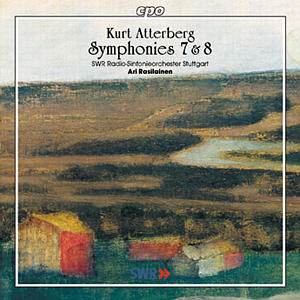The Swedish composer Kurt Atterberg has tended to be
remembered as a composer of the inter-war years, though writing in an
idiom which often suggests the music was written earlier. Earning his
living as a civil servant in the Swedish patent office, Atterberg nevertheless
composed a remarkably large catalogue of romantic music with a distinctive
voice, often touched by the sound of Swedish folk music. His output
includes nine symphonies, orchestral works, various choral works (the
ninth symphony, Sinfonia Visionaria is for soloists, chorus and
orchestra), a delightful string quartet, concertos and operas.
A nationalist composer if ever there was one, Atterberg
backed the wrong political horse during the Second World War, and although
living in a country that was not occupied, he accepted performances
of his music in Nazi Germany, including the premieres of the two symphonies
under review. Misguided opportunism possibly, but most of his music
consequently had to wait a quarter century after the war before being
heard again, and Atterberg’s later music has only occasionally been
heard since, and is only now being revived.
In 1972, two years before Atterberg died, an American
friend, the late Bennett Tarshish, critic and record collector, interviewed
Atterberg in Stockholm. Atterberg took Tarshish to a chamber music recital
promoted by a music society whose meetings the composer claimed to have
attended without break since 1908. Before Roussel’s String Trio he whispered
to his guest ‘very disagreeable piece’. The truth was that Atterberg
was a traditionalist composer, albeit with his own voice, who venerated
the models of the past.
Neither of these wartime symphonies rise to the level
of his earlier successes, the Second, Third and Sixth Symphonies, the
latter, of course, the work which won the Columbia Graphophone Company’s
1928 Schubert Centennial Competition. As war works, neither of them
seems to pay much attention to the times, possibly the composer’s reaction
to a disintegrating world was to keep the blinkers firmly on.
As far as I know neither of these symphonies made it
to LP, but both have been previously recorded on CD (Sterling CDS 1026-2)
in a pioneering recording by Malmö forces under Mikhail Jurowski.
Before that the complete unknown was the seventh symphony, but some
enthusiasts may have come across the Eighth - there is a recording by
the Swedish Radio Symphony Orchestra dating from 1960 in the Swedish
Radio sound archive and another by the Helsingborg Symphony Orchestra
and Lennart Hedwall did the rounds on tape some twenty five or more
years ago.
The Seventh Symphony of 1941-42 in fact quarries Atterberg’s
opera Fanal which had been written immediately after his Sixth
Symphony - the then notorious "dollar" symphony - in 1929-32,
and so it is not surprising that he should exhibit melodic and textual
reminiscences of the earlier symphonies in the first movement of the
three-movement seventh. Overall, I am afraid I found it no great discovery,
and it strikes me as Atterberg’s weakest symphonic work. The opening
movement is very much the curtain-up on a costume drama, the opening
bombast not hopeful for what is to follow. Though the thematic material
here, once we are fully underway is very much the world of the sixth
symphony, and not without its pleasing moments. But it is the finale
that lets it down so badly, I found it remarkably trite - the combination
of folksy dancing rhythms and colourful orchestration is an idiom Atterberg
usually relishes and it should be successful and may well be so on stage,
but here it seems so corny that one wonders if it should be followed
by a more substantial finale - and, indeed CPO’s annotator tells us
there was indeed once a fourth movement which Atterberg deleted.
In contrast, the Eighth Symphony of 1944-45 works much
better; stronger invention, the folk-derived themes working really well.
This is a delightful addition to the Atterberg canon. The slow-movement’s
cor anglais solo is a gem, while the dancing Vivo scherzo and
the catchy themes in the finale, even if much of it is a lot of business
about nothing, all add up to a charming work - as much ‘Sinfonia Romantica’
as the Seventh - and it would be good to hear a live performance.
The disc is timed at 63:33 on the box, but the CD readout
is 62:43. If you did not get the Sterling version and want to complete
your Atterberg Symphonies this can be recommended, but if you just want
to explore the best of Atterberg, go for the earlier symphonies.
Lewis Foreman

![]() SWR Radio-Sinfonieorchester
Stuttgart/Ari Rasilainen
SWR Radio-Sinfonieorchester
Stuttgart/Ari Rasilainen ![]() CPO 999 641-2 [62.43]
CPO 999 641-2 [62.43]